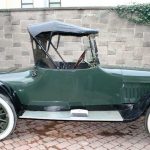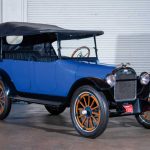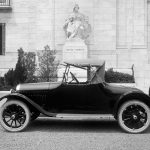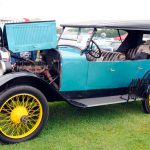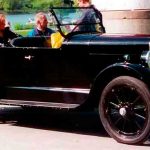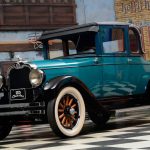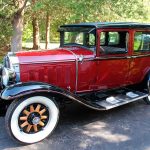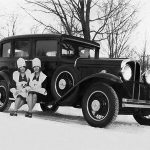Oakland Motor Car Company (1909 – 1931)

The Oakland Motor Car Company of Pontiac, Michigan, was an American automobile manufacturer and division of General Motors. Purchased by General Motors in 1909, the company continued to produce modestly priced automobiles until 1931 when the brand was dropped in favor of the division's Pontiac make.
The company was named for Oakland County, Michigan, in which it was based. As originally conceived and introduced, the first Oakland used a vertical two-cylinder engine that rotated counterclockwise. This design by Alanson Partridge Brush, inventor of the single-cylinder Cadillac and Brush Runabout, also featured a planetary transmission. The 1908 Oakland came in five body styles, designated Model A–E, varing from a runabout to a landaulet. 1908, the first year of Oakland production, saw 278 vehicles roll off the line.
GM Takeover
After one year of production, Oakland's principal founder, Edward Murphy, sold half of the company to William C. Durant's General Motors Corporation in early 1909. When Murphy died in the summer of 1909, GM acquired the remaining rights to Oakland. Within General Motors, Oakland was later slotted pricewise above the volume priced Chevrolet and below the more expensive Oldsmobile, Buick and Cadillac cars. Conventional 4-cylinder engined models were introduced shortly after the GM takeover.
In 1916, the company introduced a V8 engine,[3] and production soared to 35,000 in 1917, shared with the Chevrolet Series D. By early 1920, however, production and quality control problems began to plague the division. In 1921, under new General Manager Fred Hannum, a consistent production schedule was underway and the quality of the cars improved, and Oakland vehicles shared the GM A platform used by Chevrolet. One marketing tactic was the employment of a quick-drying bright blue automotive lacquer by Duco (a DuPont brand product), leading to the slogan "True Blue Oakland.
The Oakland car was built only in Pontiac, Michigan, which is the county seat of Oakland County. The name predates any GM association with an automobile manufacturing facility in Oakland, California, that built Chevrolet vehicles before Chevrolet joined GM called Oakland Assembly.
Pontiac
As General Motors entered the 1920s, the product ladder started with the price-leading Chevrolet marque, and then progressed upward in price, power and luxury to Oakland, Oldsmobile, Buick and ultimately Cadillac. By the mid-1920s, a sizable price gap existed between Chevrolet and Oakland, as well as a wide gap between Oldsmobile and Buick. There was also a product gap between Buick and Cadillac. General Motors pioneered the idea that consumers would aspire to buy up an automotive product ladder if a company met certain price points-called the Companion Make Program. To address this, General Motors authorized the introduction of four brands priced and designed to fill the gaps. Cadillac would introduce the LaSalle to fill the gap between Cadillac and Buick. Buick would introduce the Marquette to handle the upper end of the gap between Buick and Oldsmobile. Oldsmobile would introduce the Viking, which took care of the lower end of the same gap.
Oakland's part in this plan was the 1926 Pontiac, a shorter wheelbase "light six" priced to sell at a 4 cylinder car's price point, but still above Chevrolet. Pontiac was the first of the companion marques introduced, and in its first year sold 49,875 units. By 1929, GM sold 163,000 more Pontiacs than Oaklands. The discontinuation of Oakland was announced with the onset of the Great Depression 1931. Pontiac was the only companion make to survive beyond 1940, or to survive its "parent" make.
Image: Charles01 [CC BY-SA 3.0], via Wikimedia Commons
Credits: Wikipedia
Oakland models:
1 - Oakland Model K 40 (1910)
In 1909, the Oakland Motor Car Company of Pontiac (Michigan) launches the “OAKLAND 20” and “OAKLAND 40” models, with a total sale of … Read more “
2 - Oakland Model 30 Touring (1912)
30 bhp, 201.1 cu. in. L-head inline four-cylinder engine, three-speed selective sliding-gear transmission, solid front axle with semi-elliptic leaf-spring suspension, semi-floating rear axle … Read more “
3 - Oakland Model 37 Speedster (1915)
Oakland created a five-car lineup for 1915. It was based entirely on the Light Four and Light Six chassis. Left-hand steering was now … Read more “
4 - Oakland 32-B Touring (1916)
For 1916 Oakland offered a Light Four called the Model 38 that was much like the previous Model 37 and an all-new Light … Read more “
5 - Oakland Model 34-B Roadster (1918)
Better engine manifolding and new cooling fan were the chief merits of the 1918 Oakland Model 34-B. New features found in the engine … Read more “
6 - Oakland Model 34-B Touring (1918)
44 hp, 2900 cc. Northway L-head inline six-cylinder engine, three-speed manual transmission, solid front axle, full floating rear axle, and rear-wheel drum brakes. … Read more “
7 - Oakland Model 34-C (1920)
The most obvious change in 1920 Oaklands was a three-inch linger wheelbase. Being larger, the new Oaklands weighed more and required some technical … Read more “
8 - Oakland Model 34-D Touring (1922)
The first 1922 Oaklands, appearing on the assembly line in August of 1921, were refined versions of the Model 34-C with better fit … Read more “
9 - Oakland Model 6-44 Touring (1923)
1923 Oakland Model 6-44 five-passenger touring. (AA)
OAKLAND — MODEL 6-44 — SIX — A new Sports Roadster was included in the 1923 Oakland … Read more “
10 - Oakland Model 6-54 sedan (1924)
The body lines of the all-new 1924 Oaklands were generally more rounded than in the past few years. Shorter running boards were seen. … Read more “
11 - Oakland Model 6-54B Sedan (1925)
Changes and improvements in the Oakland for 1925 included larger cylinder bores, a higher compression ratio, a new Stromberg carburetor, the use of … Read more “
12 - Oakland Model 6-54C Greater Six Landau Coupe (1926)
The Closed-body Oaklands 6-54C had new styling with attractive twin belt moldings, a new headlight design, and a tie-bar linking the lights in … Read more “
13 - Oakland All-American Six Landau Sedan (1928)
The all-new Oakland All-American Six had a new 212-cid L-head engine and a longer 117-in. wheelbase.
Seven body styles were offered. The general … Read more “
14 - Oakland All-American Six 3P Coupe (1929)
Highlighting the second series of Oakland All-American Six models were new body designs with higher hood lines and belt lines, lower rooflines and … Read more “
15 - Oakland V-8 Model 101 Custom Sedan (1930)
The 1930 Oakland 101 was the first eight that the company had built since 1917. It was based on a 117-in. wheelbase and … Read more “
16 - Oakland V-8 Model 301 Custom Sedan (1931)
Longer and lower Fisher bodies with a single, wide belt molding were carried on the 1931 Oakland chassis.
They were similar to Pontiac … Read more “




